What is Sambalpuri Ikat?
Ikat, a word known to be derived from the Indonesian word, ‘Mengikat’, which means to tie, is a term that is used in the Sambalpuri textiles. In a more cultural context, this is also known as the bandha kala, owing to the resist tie and dye method, in Odisha, and is also called the Sambalpuri bandha. It is traditionally handwoven and is known worldwide for its incorporation and inclusion of many traditional motifs and designs such as shankha, chakras and phula, which as shells, wheels and flowers, respectively, and hold a large significance to the birth state of the textile, which is Odisha and is also done on red and black backgrounds, which are once again a traditional Odia culture. These colours, along with some colours of Lord Jagganath’s face, are used, and the craftsmanship of the saris is reflected through the intricate weaves.
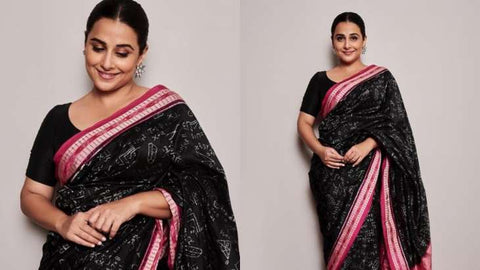 {Image Credit:- Indiatv News}
{Image Credit:- Indiatv News}
Details and History of Sambalpuri Ikat:
The Sambalpuri fabrics are known to reflect the original style of Baandha, which was created by traditional craftsmen and artists by depicting flora and fauna or even through geometric patterns. Bandha fabric, as mentioned before, is made using a tie and dye technique, and the yarns used for the textile are tied according to the desired and wanted patterns to prevent the absorption of dyes, after which it is dyed in the desired colors. The sets of yarn and pieces of yarn are known as “Baandha”, and one of the most interesting facts about this is that the threading of the yarn is the same on both sides of the fabric. The fabric is known to be unable to change its colour once it is dyed, but the versatile technique of this method helps in the creation of some very interesting and unique designs and patterns that can be woven. The weavers use this to convey important messages and thoughts through their work.
The history of Sambalpuri art tells us that this weave had migrated from Western Odisha, with the Bhulia community, that originally fled from the northern parts of India, known to be in the year 1192 AD, post the fall of the Chouhan empire, which the Mughal rulers did. Since then and till 1925, it had flourished in Western Odisha, and these sarees were known as “Bhulia-Kapta”.
If one may be concerned with the question, how to identify Sambalpuri Ikat? They can be advised to look out for many featured and defined motifs and designs made with precision and patience by the artisans' generational skills. Unlike other Ikat crafts that use wave-like designs and motifs in their textiles. The designs that are worked on are usually cotton-based, and this property helps ensure that the colour used seeps deeper into the fabrics and helps make the cloth suitable for almost all seasons and weather. Some examples of the motifs are animals like elephants, ducks, lions and even deer, as well as using some floral designs as motifs. The Kumbha or temple symbols, as well as the Konark wheels, are a popular motif commonly used.
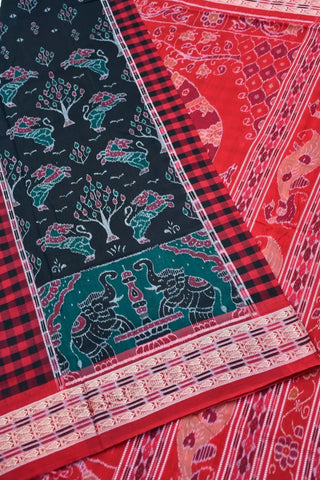
{Image credit:- Wikipedia}
Interesting facts about Sambalpuri Ikat:
Connection with Goddess Samalei:
Sambalpuri sarees have a deep connection with Goddess Samalei and originated from her town of Sambalpur. The textiles are widely loved and worn in Odisha and are characterised by woven pallus and extraordinary borders of contrasting and vibrant colours, as well as depictions of designs from Odia temples, of temples of Odisha. The motifs on the fabric narrate stories and tales of epics, nature, and society.
Handloom technique of Sambalpuri Ikat:
One of the most desired and hyped handlooms of the weaving industry uses the double ikat weaving technique, and it is used in the making of the Sambalpuri Ikat textiles. It is considered one of the most prized and precious parts or possessions of the selection of handlooms from Odisha.
The recognition of Sambalpuri Sarees:
One of the lesser-known facts about the recognition of Sambalpuri sarees is that it was introduced famously to the world when the Late Mrs Indira Gandhi wore them on multiple political occasions in the mid-1980s. It also created a buzz when it was found that they reflected an original style of art known as the Baandha, which is popularised through the Bandhakala craftsmanship.
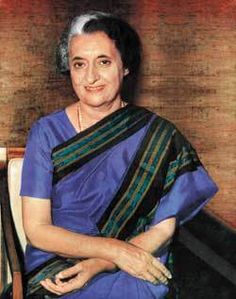 {Image credit :- Pinterest}
{Image credit :- Pinterest}
Sambalpuri Ikat in today’s world:
Baandha fabric, in today’s times, is famously known by its geographical and cultural term and name, which is Sambalpuri, and this was done by the efforts of one of its pioneering mentors Sri Radhashyam Meher, who started a movement of improvement in the skills of all the craftsmen as well as the quality of the products that were made by them. Sambalpuri in today’s time is included in furnishing materials as well as dress materials in sarees that are made from silk, cotton and even mercerised cotton in a large variety of colours that also have different designs. The Baandha craftsmen are also experts in the ‘extra warps’ and the ‘extra weft’ of designing, which is seen in almost all the forms of Baandha textiles.
Sambalpuri sarees are known to be the very first selection or choice for every Oria woman, and they favour this style for any and every special occasion. The Meher tribe is one of the famously known tribes that have been practising this weave for generations and have added alterations and innovative styles to it as the years pass. Sambalpuri ikat is known to be resistant to heavy and rapid wear and tear material, which makes it more special than other crafts. This weave is used to style a variety of textiles, such as those dresses, jackets, kurtas, and even stoles. Sambalpuri ikat has also started being incorporated into jewellery and bags, giving them a vibrant and classy look.
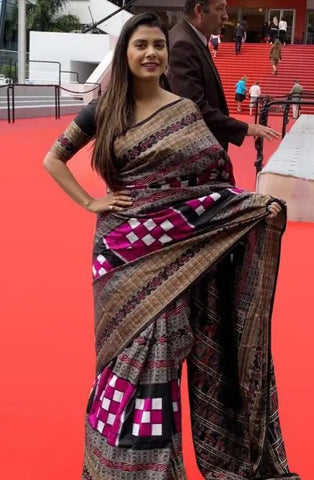 {Image Credit:- Pinterest}
{Image Credit:- Pinterest}
iTokri and Sambalpuri Ikat:
iTokri is known to have one of the most exclusive collections of handmade fabrics, especially those of Sambalpuri fabrics. One can use this platform to shop for their favourites. From adorning Sambalpuri hand-woven dupattas to add style and colour to Indian wear such as kurtis and dresses to Sambalpuri ikat dress materials which can be used to create some lovely outfits, there is a wide range of options that one can choose from. One of the most special of these garments is the Sambalpuri ikat Sarees, which would be an exciting addition to one’s closet saree collection!
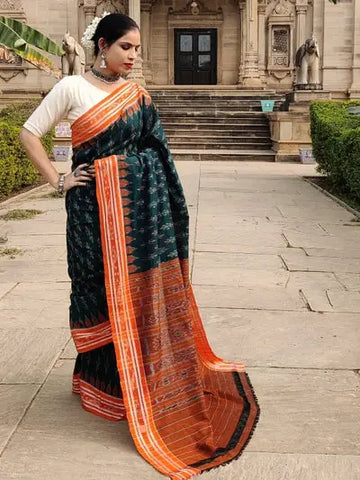
FAQS
- Where does the word Ikat derive from?
Ikat, a word known to be derived from the Indonesian word, ‘Mengikat’, which means to tie, is a term that is used in the Sambalpuri textiles.
- What is Sambalpuri Bandha?
It is traditionally handwoven and is known worldwide for its incorporation and inclusion of many traditional motifs and designs such as shankha, chakras and phula, which as shells, wheels and flowers, respectively, and hold a large significance to the birth state of the textile, which is Odisha and is also done on red and black backgrounds, which are once again a traditional Odia culture. These colours, along with some colours of Lord Jagganath’s face, are used, and the craftsmanship of the saris is reflected through the intricate weaves.
- Where did Sambalpuri originate from?
The history of Sambalpuri art tells us that this weave had migrated from Western Odisha, with the Bhulia community, that originally fled from the northern parts of India, known to be in the year 1192 AD, post the fall of the Chouhan empire, which the Mughal rulers did.
Since then and till the year 1925, it had been flourishing in Western Odisha, and these sarees were known as “Bhulia-Kapta”.
- What is the handloom technique used for Sambalpuri?
One of the most desired and hyped handlooms of the weaving industry uses the double ikat weaving technique, and it is used in the making of the Sambalpuri Ikat textiles. It is considered one of the most prized and precious parts or possessions of the selection of handlooms from Odisha.
- What is Sambalpuri Ikat used for?
Sambalpuri ikat is known to be resistant to heavy and rapid wear and tear material, which makes it more special than other crafts. This weave is used to style a variety of textiles, such as those dresses, jackets, kurtas, and even stoles. Sambalpuri ikat has also started being incorporated into jewellery and bags and gives them a vibrant and classy look.
References:
https://en.wikipedia.org/wiki/Sambalpuri_sari
https://www.itokri.com/collections/sambalpuri-ikat-sarees-online
blogs you might also like
8 markets in Delhi to shop handicrafts
Pattachitra paintings
What is the diffrence between natural dyes and chemical dyes?
 Verified Purchase
Verified Purchase






































Leave a comment (all fields required)